Preparing for Swine Flu and Other Animal-Borne Infections
The H1N1 swine flu virus has already been identified as a new virus, with genes from human, bird, and pig influenza viruses. Symptoms include fever, coughing, sore throat, body aches, headache, chills, fatigue and, in some cases, vomiting and diarrhea. In severe cases, it may lead to pneumonia, multi-organ failure, and death. The incubation period is two to five days. Currently there have been relatively few deaths worldwide, but matters could become worse in the winter months—you should expect no serious risk of infections in the Northern Hemisphere until then; possibly because of the high ultraviolet light exposure during the summer and early fall. The 1918 Spanish flu pandemic, which killed 20 to 40 million people worldwide, began with a mild wave of infections in the spring, but the virus returned a few months later in a far more dangerous form. With international air travel the disease could spread rapidly. Worse than the infection could be the disruption of trade and the economy that follows an outbreak. Everything you take for granted (grocery shelves filled with food, gasoline, heating fuels for your home, TV, etc.) may be no longer be available, soon after a serious outbreak.
There are no current effective vaccines. My last experience with Swine Flu vaccine was in 1976—two of my patients became permanently paraplegic from the vaccine. The vaccine turned out to be more dangerous than the original flu outbreak, which killed only one person. From the vaccination of 40 million Americans, 25 people died and 500 were affected with Guillain Barré syndrome, a serious neurological disorder. We have learned much since then about vaccines. But don’t count on this method for your salvation because effective vaccines are difficult to produce against a virus like swine flu that changes genetically so easily. The routine ‘flu shot’ that will be offered this fall will offer no protection from swine flu. If an effective, safe vaccine for swine flu does become available, I will personally take it.
Antibiotics are not effective against viruses. Antiviral agents (Tamiflu and Relenza) are of limited value because resistance has developed. They may reduce the duration and severity of the flu—so keeping a stockpile could be wise. Tamiflu is most commonly recommended and can be purchased with a prescription (A 10 pill regime for one adult is about $60). No special diet, herb, or vitamin supplement will protect you from becoming infected or dying.
Your best chance to avoid infection is to avoid the virus. Everyday habits of hand washing and not touching your face should be practiced. Wearing a mask is a public-spirited act, adding to the panic, but offering little to no protection. The day may come when isolating yourself and your family may make the best sense. You should be prepared. Suggestions on stocking food are found in my March 2008 newsletter article: Cutting Food Costs in These Times of Economic Downturn. Drinking water will be necessary. Also consider a solar oven. These recommendations for preparedness may sound paranoid to some of you, and I do not like spreading unnecessary fear—but we live in dangerous times.
Long term, the solution to preventing the most devastating viral epidemics is to change the world’s food supply. The origin of bird and swine flu viruses is the factory farming of animals (chickens and pigs). My recommendation for a worldwide change to a starch-based diet to prevent and cure common diseases of over-nutrition (heart disease, cancer, type-2 diabetes, obesity, etc.) and to slow environmental destruction, applies also to the prevention of influenzas. This is just one more big reason to support the Starch Solution (See my February 2009 newsletter).
For those interested in a detailed discussion of the origins of the swine flu virus you can read this article by Michael Greger, MD, Factory Farms: Recipe for Disaster
Recommended Articles

The Truth About Starch (Anti Wheat Belly & Grain Brain)

The Scientific Publications of Dr. Walter Kempner: Creator of the Rice Diet






